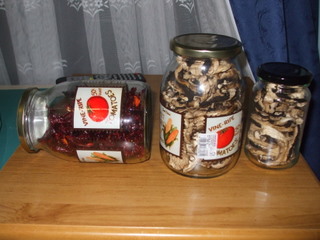On this website you will find two articles, one on building homemade solar food dryer and the other on a simple direct solar food dryer to allow you to preserve your food by removing the moisture from it, but up until now, nothing about the process of drying. This article will give you an introduction in how to start using your dryer and enjoying what it produces.
Before we get started I would just like to discuss mindset, or more particularly my mindset, I can get set in my ways sometimes...... I originally built my dehydrators to preserve the product of my veggie garden, thereby extending the length of time that I had to enjoy that product. A few years ago I change the system that I used to produce food out of our veggie garden so that we no longer get the large gluts of food followed by months of little or no produce so the solar drier went away into the shed and has not seen a great deal of use lately.
Recently it has penetrated my thick skull that it is a valid and sustainable use of the drier to take advantage of cheap and in season fruit and veggies, particularly when those fruit and veggies are sourced from local farms directly at the farm gate or through local farmers markets. So you hopefully see with me that it is worth making and using a solar drier, even if you don’t have a veggie garden. It can still help you enjoy nature’s bounty, at times when nature isn’t being so bountiful.
Some Basic Rules
- To get the best out of your drier, put the best in. In other words the best quality produce at the peak of its freshness is what you should be drying, not the tag ends of stuff that got left in the fridge and need to be used up before they go off.
- Prepare the food to be dried correctly. Make sure you understand that some vegetables need to be blanched and some fruits require to be preserved by sulphuring (yuk) or addition of vitamin C.
- Place the cut produce in one layer only on the drying tray, not touching each other.
- Keep an eye on you produce to make sure that it gets the drying it needs. Storing not fully dried fruit, vegetables and meat can be a recipe for fungus or food poisoning.
- Store you dried food correctly in an airtight container in a cool dark place to get the best shelf life out of that produce you have worked so hard to make.
-
Be diligent about your labelling so you know absolutely what is in that pack of dried up pinky black stuff and how long it has been there. It can save lots of worry or discarded food.
DRYING VEGETABLES
Wash and dry the vegetables thoroughly and remove any tops and/or roots and slice 3-4mm thick as uniformly as possible to ensure even drying. Where appropriate blanch the vegetables by placing in boiling water for 3 to 6 minutes or steaming or microwaving for 4 to 6 minutes. Blanching has the following beneficial effects –
- It destroys any bugs which cause spoilage,
- Deactivates the enzymes which cause ripening, preventing the vegetable from continuing to age,
- Reduces vitamin loss,
- Preserves the colour of the vegetable, and
- Relaxes cell walls to make the drying process quicker.
Leave the vegetables in the drier until the desired state of dryness is achieved which usually results in a crisp or brittle texture, which may require removing the produce from the drier and storing in the house overnight if you are using the solar drier. Pack off immediately to prevent any re-absorption of moisture.
DRYING FRUIT
Cut the fruit in half and remove pit if present and dip in a solution of one table spoon of vitamin C powder (ascorbic acid) to 4 litres of water for two minutes then allow to drain. Place in the dehydrator. Most fruit has finished drying when still pliable but leathery.
DRYING MEAT
Generally speaking meat is dehydrated to produce either a jerky or biltong like product which is not cooked prior to drying and is eaten “as is” or meat to be rehydrated in soups or stews etc and this is cooked before dehydrating. In either case all fat should be removed prior to drying because the fat will go rancid, reducing the shelf life of the product.
Meat to be used in cooked dishes should be cooked to the point where it done but still tender then sliced for dehydrating and the dried until crisp. The making of jerky and biltong is a more specialised process and will be the subject of another article.
Rehydrating Dried Product
Vegetables may be rehydrated by soaking each cup of dried vegetables in two cups of hot water for half an hour then cooked until tender or alternatively they may be added to soups or stews at the start of the cooking process. Fruit may be rehydrated by soaking each cup of dried fruit in one cup of warm water until the fruit is soft and plump or alternatively it may be eaten directly in its dried form. As mentioned above, dehydrated meat should also be added to the soup or stew at the start of the cooking process.




